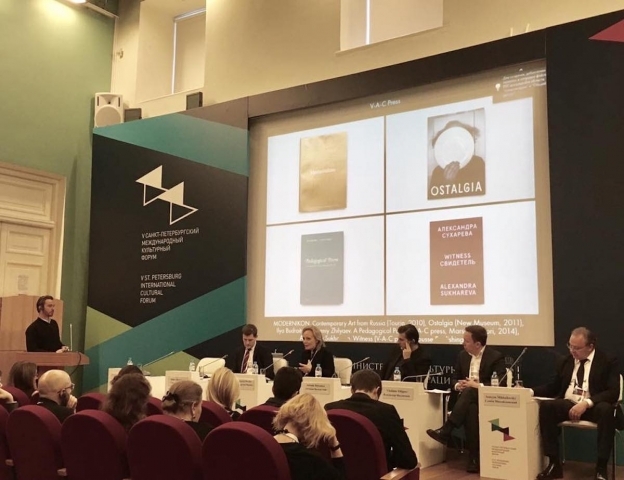Creative Environment and Urbanism: Russia in the international cultural dialogue

A discussion “Russia in the international cultural dialogue” was held during Saint-Petersburg cultural forum with the participation of Sergei Kuznetsov, Teresa Mavika, Semyon Mikhaylovskiy, Antonio Belvedere and Vladimir Filippov.
Lukas Feireiss, urbanist and writer: “Globalization rules the world now, and we have to admit each other’s competing views on culture, society, traditions, and to act in a thoughtful and responsible manner. Understanding of culture in this process has great importance especially in times of international tension and sanctions.
Openness, respect between people belonging to different communities, exchange of ideas, cultural practices, works of arts, is the only way to avoid misunderstanding in the world. Of course, there is a risk that all these can be used in a negative meaning, as a part of propaganda, but it is important to remember that political actions are temporary, while culture and art are eternal.
Architecture historically and politically always exists in people’s everyday life. It creates culture, opens boundaries between countries, forms communication. Every building possesses semantic qualities and properties: it transfers and broadcasts, unites and opens new horizons. Architecture is a great power and it suggests big responsibility.”
It’s necessary to remember that architecture is not only walls, but also bridges between nations and cultures
“Culture has no passport, it’s always needed to encourage open dialogue. People who are engaged in politics are living here and now. If you want to live in other way, you choose culture”, — supported her colleague Italian Teresa Iarocci Mavica, director of Russian fund “Victory — the art of being contemporary”. She told about role of patron of arts in Russia, perception of Russian artists in the Western world and how emerged the idea to turn former GES-2 building into a new museum complex.
“We call GES-2 a generosity project. These are 2 ha of land in the centre of Moscow, which have never been the city’s property. Our task is to return this territory to the city. It means to make a huge step ahead and to create a new meaning for the word museum. GES-2 will be opened in May of the next year”, — Teresa Mavika marked.
GES-2 won’t be a site where something is stored and displayed. It will rather continue to be a station, but now a culture will be produced here
“For me, as a director, the main task became producing Russian contemporary art and a chance to set slightly another pace to this art, to make it better known abroad. We started to invite Western curators, and finally we managed to create a group of allies which we are actively cooperating with”, — she added.
Deputy Head of the Department of Culture of Moscow Vladimir Filippov told about summit of Cultural forum of the world’s cities which took place from the 5 to the 7 of October at important cultural venues: VDNKh, Multimedia Art Museum Moscow, “Garage”, ZIL cultural centre, “Stanislavsky” Electrotheatre, The Pushkin State Museum of Fine Arts, Pashkov House. This year the summit was dedicated to the key role of culture for successful and harmonious development of modern cities.
“City’s success can also be estimated by reasons why and in which quality people want to come to your city to live and work there. And this is a question of city’s reputation and people, who form city’s image in different areas through culture and welcoming environment”, — Filippov said.
Chief Architect Sergei Kuznetsov: “I want to express my gratitude to Deputy Prime Minister Olga Golodets and Minister of Culture Vladimir Medinsky for creation of section of architecture and urbanism within international cultural forum. Petersburg — is a dramatic example of how the dialogue takes place, so this is a perfect venue for such meetings. In Moscow we initiated international architectural contests, promoting cultural exchange as well. Inviting foreign architects we contribute to the pro-competitive development, our architects learn while contesting with the world’s best professionals. To all those who are against contests I’ll answer: I think that architectural object belongs to the place where it’s located more then to its creators. Foreign projects in Russia, they all became Russian long ago. Besides, we try to participate at various international venues: Venice and Argentina biennale, EXPO in Milan... All these bring fruit, for instance, National Geographic has included VDNKh in the list of world’s must-visit places.”
Importance of environment for architecture has also been marked by Antonio Belvedere, Renzo Piano partner: “If the customer wants to create something „notable„ in a wrong place, then the dialogue will not work. Of course, it depends a lot on what values rule in the country. Architects in Russia face a number of difficulties, but you have a wonderful generation born in 90s, they possess some freshness and certain naivety. That’s why I suppose Russia is a good place for experiments“.
Semyon Mikhaylovskiy, dean of the I. E. Repin State Academic Institute of Painting, Sculpture and Architecture, touched on the topic of „Russian way“. „Every part of the world has its specific features. And I like that they are different. This variety charges us with energy. In this situation it is important for us, being so different to learn how to live together“.
- Tags:
- Sankt-Petersburg



